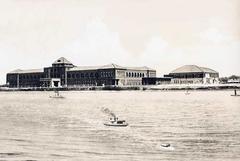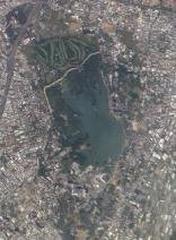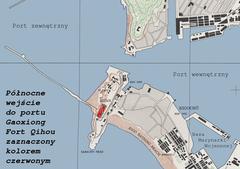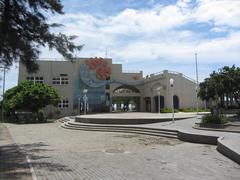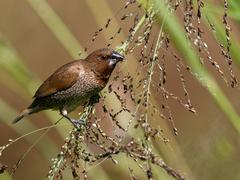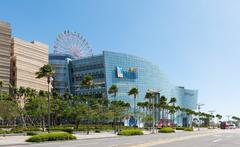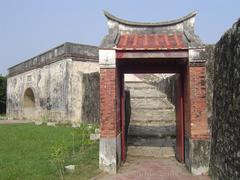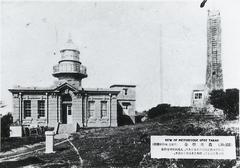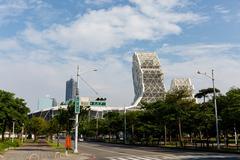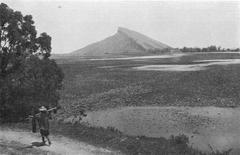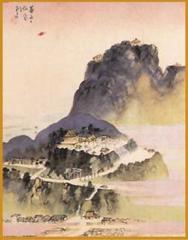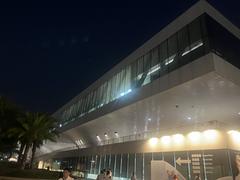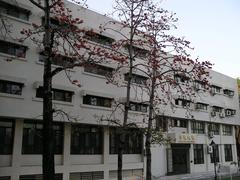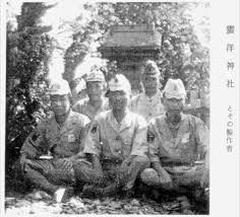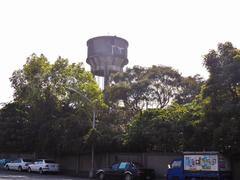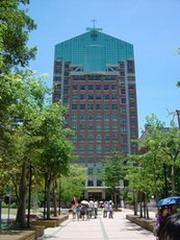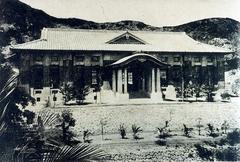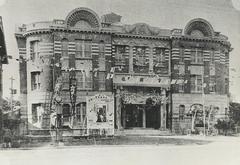Agongdian Reservoir: Visiting Hours, Tickets, and Comprehensive Travel Guide to Kaohsiung’s Historic Landmark
Date: 04/07/2025
Introduction
Agongdian Reservoir (阿公店水庫) in Kaohsiung, Taiwan, is a remarkable convergence of natural splendor, historical depth, and engineering achievement. Established during the Japanese colonial period and completed in the early 1950s, it stands as Taiwan’s first post-war reservoir and, at its inauguration, was the longest dam in Asia. Beyond providing essential water resources and flood control, the reservoir has evolved into a beloved destination for recreation, ecological exploration, and cultural appreciation. This detailed guide covers its history, practical visitor information, major attractions, accessibility, and essential travel tips to ensure a rewarding visit.
Historical Background and Significance
Origins and Construction
The Agongdian Reservoir was conceived in the early 1940s under Japanese colonial administration to address recurring flooding and drought in southern Taiwan’s fertile plains. Interrupted by World War II, the project was resumed and completed in 1953 under the Republic of China government (FourH). The reservoir’s primary objectives were flood prevention, irrigation, and municipal water supply—functions that spurred the agricultural and urban development of Kaohsiung and neighboring regions.
Symbol of Post-War Modernization
Completion of the reservoir marked a significant milestone in Taiwan’s infrastructure development, symbolizing both technological advancement and the drive for post-war reconstruction. Its name, “Agongdian,” meaning “Grandfather’s Shop,” is rooted in local folklore and pays homage to the Agongdian River, which it harnesses (FourH).
Environmental Evolution and Sustainable Initiatives
Over the decades, sedimentation and pollution posed challenges, prompting substantial renovations between 1998 and 2006 to restore capacity and improve water quality. In 2017, the reservoir became home to Taiwan’s first floating photovoltaic solar power plant, underscoring its role in sustainable energy innovation.
Functional and Ecological Value
Water Resource Management
Agongdian Reservoir is integral to regional water management:
- Flood Control: Mitigates flooding for Kaohsiung’s low-lying farmlands and urban areas.
- Irrigation: Supports thousands of hectares of agricultural land.
- Municipal Supply: Provides potable water for the city, especially during dry seasons (FourH).
Biodiversity and Habitat
The reservoir and its surrounding forests foster a vibrant ecosystem, providing habitat for fish, amphibians, waterfowl, and native plant species. Its relative seclusion has allowed local biodiversity to thrive, making it an important site for ecological research and environmental education.
Conservation Challenges
Sedimentation, invasive species, and climate change require ongoing management to balance human activity with ecological preservation (Sustainable Tourism Alliance).
Cultural and Social Importance
Local Identity and Folklore
The reservoir is a source of local pride, entwined with legends about its namesake and the “grandfather’s shop” once located nearby. It serves as a living testament to the resilience and ingenuity of the region’s communities.
Recreation and Tourism
From its utilitarian beginnings, Agongdian Reservoir has blossomed into a recreational haven. The adjacent Ta-di Mountain Natural Park and forested areas offer walking and cycling paths, birdwatching opportunities, and tranquil lakeside vistas (FourH). Its off-the-beaten-path location ensures a peaceful atmosphere for visitors.
Visiting Information
Opening Hours
- Daily: 6:00 AM – 6:00 PM
Early opening hours allow visitors to enjoy the sunrise and cooler morning temperatures.
Entry and Tickets
- Admission: Free of charge
No tickets are required for general entry. Special events or guided tours may require advance booking and a nominal fee—check official sources for the latest information.
Accessibility and Transportation
- By Car: Easily accessible from Kaohsiung via National Highway No. 1, exiting at Ganshan Interchange. Follow County Road 186 and Yanchao Xinsheng Road to reach the main entrance (TravelKing).
- By Bus: Kaohsiung Bus services connect to Ganshan and Yanchao, with stops near the reservoir (TravelKing).
- By MRT: The nearest metro station is Ganshan; from there, transfer to a local bus or taxi (Kaohsiung Metro Guide).
- Cycling: Kaohsiung’s YouBike system allows convenient access to explore the area (KHH Travel).
Facilities
- Parking: Multiple lots are available but may fill up on weekends or holidays; early arrival is advised (Ating Blog).
- Restrooms: Located near entrances and along main trails.
- Shelters and Seating: Shaded rest areas and benches are provided.
- Food and Refreshments: Limited options onsite; consider bringing your own snacks or visiting nearby towns for meals.
- Accessibility: Main dam trail is paved and suitable for wheelchairs and strollers. Some forested paths are uneven.
Key Attractions and Activities
Dam Trail (壩堤步道)
- Length: Around 2 kilometers
- Features: Panoramic reservoir and mountain views, ideal for walking, jogging, and cycling. Particularly scenic at sunrise and sunset.
Longkou Fountain (龍口噴泉)
- A notable “Ten Scenic Spots of Agongdian,” this bell-mouth spillway is best seen during the June–September low-water period (Ating Blog).
Forest Park (森林公園)
- Lawns, shade trees, playground, and a large pond (caution: pond is unfenced).
Siaogangshan Long Embankment
- Offers sweeping lake views and is a favorite spot for sunset photography. The adjacent lakeside café provides refreshments and a relaxing atmosphere (Kaohsiung Tourism).
Birdwatching and Nature Photography
- The diverse habitats attract various bird species, especially during migratory seasons. Bring binoculars and a camera to capture the reservoir’s vibrant flora and fauna.
Events and Seasonal Highlights
- Community Events: Spring and autumn festivals, outdoor markets, and cultural performances often take place onsite.
- Cherry Blossom Season: The reservoir area is particularly beautiful during cherry blossom bloom.
- Guided Tours: Occasionally available through local tourism offices or environmental organizations, especially during special events.
Safety, Accessibility, and Visitor Etiquette
- Paths: Most main routes are accessible, but some areas may be steep or lack railings—exercise caution.
- Pets: Allowed on leashes; check for posted restrictions.
- Children: Supervise near water and on elevated paths.
- Cleanliness: Help preserve the environment by disposing of trash properly and respecting wildlife.
- Weather: Summers are hot and humid—bring water, sun protection, and insect repellent.
Practical Visitor Tips
- Best Time to Visit: October to April for mild weather and clear skies (Chris and Wren’s World); late afternoon for sunset views.
- What to Bring: Comfortable shoes, water, sun protection, snacks, camera, and binoculars.
- Weekdays vs. Weekends: Weekdays offer a quieter experience; weekends and holidays can be crowded.
- Nearby Amenities: For more dining or lodging options, visit Yanchao or Ganshan districts.
Nearby Attractions
- Xiaogangshan (小崗山): Hiking trails with panoramic views.
- Eye of Gangshan (崗山之眼): Skywalk with glass-bottom sections (Trip.com).
- Dadong Wetlands Park: Rich biodiversity and scenic walking paths.
- Dadong Arts Center: Cultural exhibitions and city views.
- Local Markets: Experience traditional Taiwanese snacks and cuisine in Yanchao and Ganshan.
Frequently Asked Questions (FAQ)
Q: What are the Agongdian Reservoir visiting hours?
A: Daily from 6:00 AM to 6:00 PM.
Q: Is there an entrance fee?
A: No, general admission is free. Some events or tours may require a fee.
Q: Can I reach the reservoir by public transportation?
A: Yes, via local bus connections from Kaohsiung and transfers from MRT Ganshan station.
Q: Are pets allowed?
A: Yes, with leashes. Check for specific restrictions onsite.
Q: Are guided tours available?
A: Occasionally, especially during festivals or by arrangement through local groups.
Q: Is the area wheelchair accessible?
A: Main dam trails are accessible; some side paths may be less suitable.
Q: When is the best time to see the Longkou Fountain spillway?
A: June to September during the reservoir’s low-water season.
Visual and Media Resources
High-resolution images, maps, and virtual tours are available through the Kaohsiung Tourism website and local travel blogs. Photogenic highlights include the dam trail, Longkou Fountain, lakeside sunsets, and forest park scenery.
Call to Action
Ready to explore Agongdian Reservoir and Kaohsiung’s historical sites?
- Download the Audiala app for real-time travel updates, itinerary suggestions, and exclusive tips.
- Visit official tourism sources and travel blogs for the latest information.
- Follow us on social media and check related posts to enhance your Taiwan travel experience.
Summary
Agongdian Reservoir is a testament to Taiwan’s resilience, engineering progress, and environmental stewardship. From its roots in post-war reconstruction to its present role as a sanctuary for recreation and ecological education, it offers visitors a unique blend of history, culture, and natural beauty. Free access, well-maintained facilities, and diverse attractions ensure a welcoming experience for all. Whether you’re interested in water management history, outdoor adventures, or tranquil scenery, Agongdian Reservoir stands out as a must-visit destination in Kaohsiung.
References
- Agongdian Reservoir in Kaohsiung: Visiting Hours, Tickets, History, and Attractions (Kaohsiung Tourism)
- Agongdian Reservoir Visiting Hours, Tickets, and Guide to Kaohsiung’s Historic Water Landmark (FourH)
- Agongdian Reservoir Visiting Hours, Tickets, and Travel Guide in Kaohsiung (Ating Blog)
- Kaohsiung Tourism Official Website (Kaohsiung Tourism)
- Sustainable Tourism Alliance on Impact of Tourism on Local Communities (Sustainable Tourism Alliance)
- Chris and Wren’s World Kaohsiung Travel Guide (Chris and Wren’s World)
- Eye of Gangshan Attraction (Trip.com)
